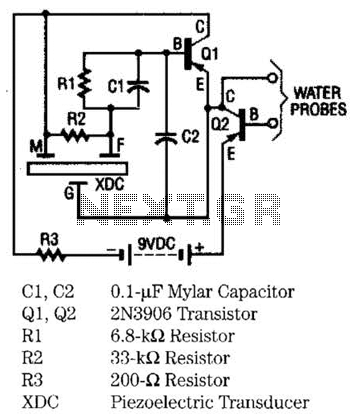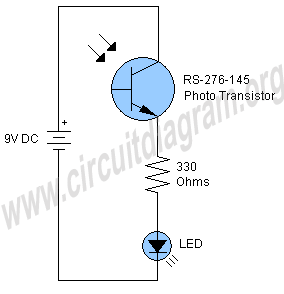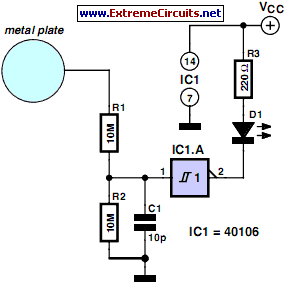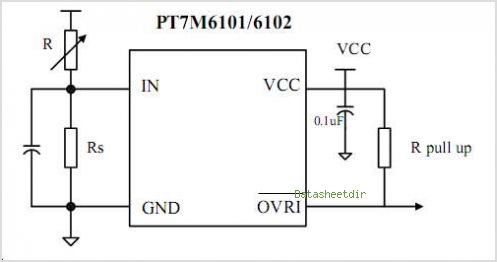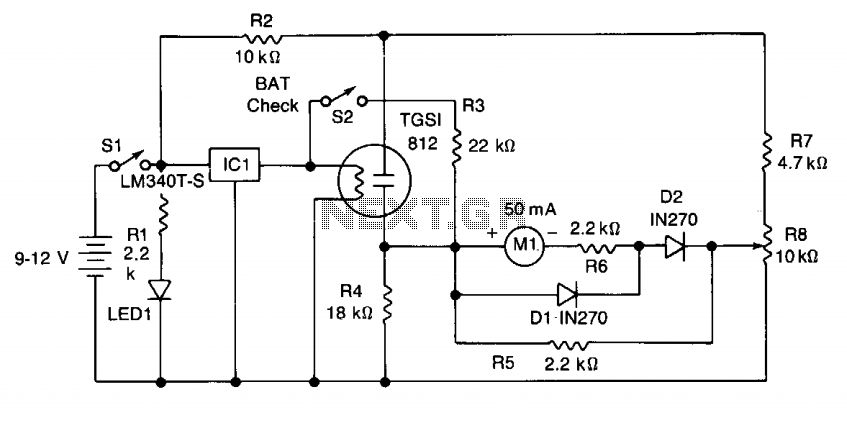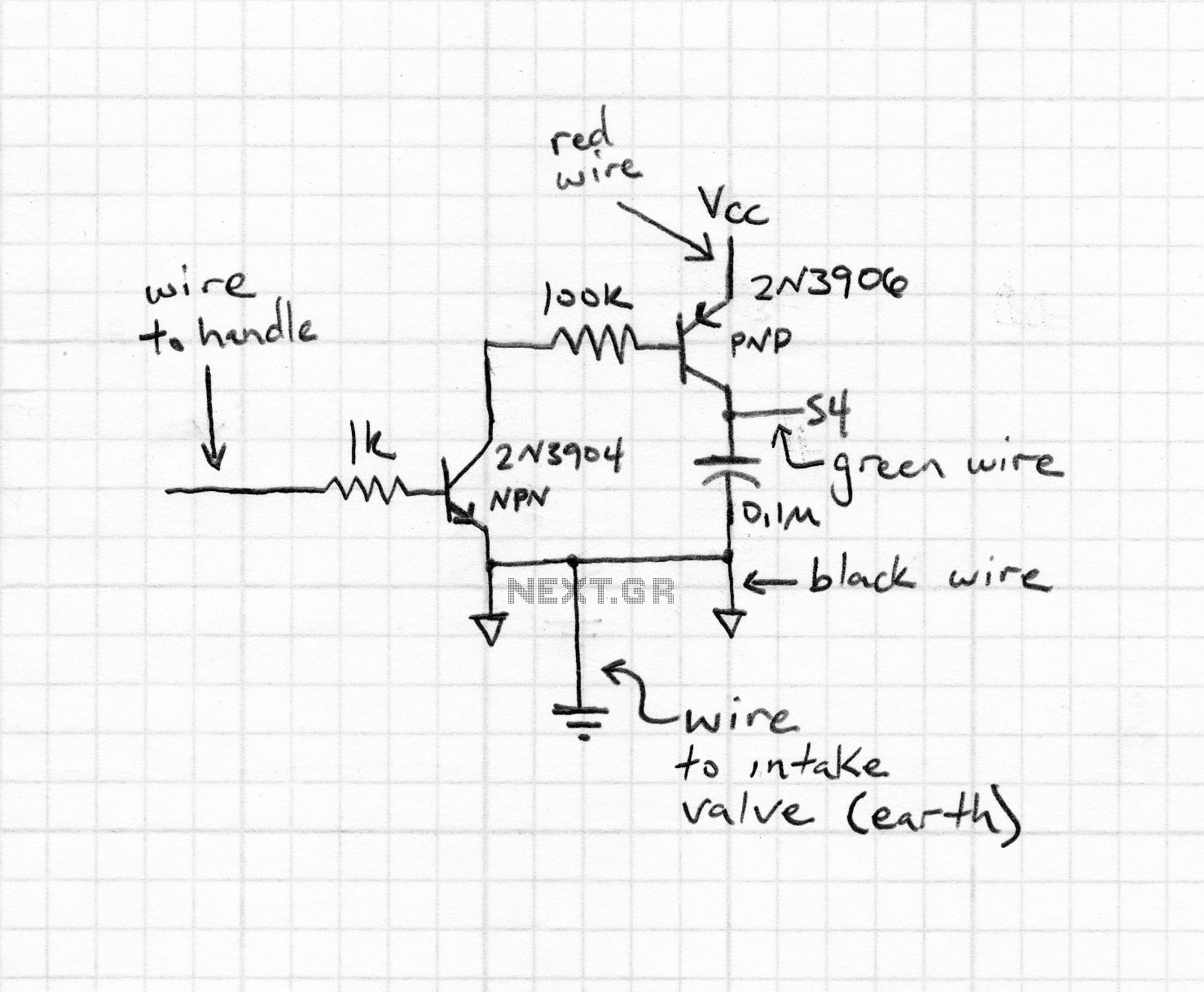
NE612 heterodyne detector

This schematic represents a simple direct-conversion heterodyne detector with a tuning range of approximately 10 kHz to 120 kHz, optimized for use with an electret microphone. The circuit operates with a low current consumption of only 8 mA, allowing for an operational duration of about 100 hours with a set of rechargeable batteries. When tuned to around 35 kHz, it is capable of detecting the 32,768 Hz signal from a vibrating crystal inside an electronic wristwatch held near the microphone. The signal from the MCE-2500 electret microphone is amplified by a pre-amplifier, mixed with a square wave from a variable oscillator, and subsequently low-pass filtered and amplified for headphone output. The electret microphone is a specialized small type that can pick up sounds up to at least 60 kHz, although the signal-to-noise ratio decreases at higher frequencies. The microphone consumes approximately 0.45 mA, remaining relatively independent of supply voltage. A 4.7 kΩ resistor is used to set its DC voltage at around 2.1 volts below the battery voltage. Given the current-source characteristics of the microphone, this resistor dictates the source impedance. The first transistor in the circuit is a low-noise BC550C type, which offers a high current gain, resulting in lower base current requirements. The datasheet specifies a low noise setpoint of 200 μA collector current for a source impedance of 2 kΩ; however, a lower collector current of 100 μA is selected due to the higher source impedance of 4.7 kΩ. A capacitor from the emitter to ground is included to create a rising gain versus frequency characteristic, achieving maximum gain (approximately 50) at around 100 kHz. The final transistor functions as an emitter-follower to buffer the amplifier's output, providing a low output impedance for the mixer stage. A 4046 PLL IC serves as the square wave oscillator, noted for its linear voltage-frequency relationship and low power consumption. The resistor and capacitor values allow for frequency settings from 10 kHz to approximately 120 kHz. The VCO signal from the 4046 is buffered through the internal phase detector and exits at pin 2, where it is fed into a resistive divider to produce a signal with an amplitude of about 260 mV, suitable for input into the NE612 mixer. The NE612 mixer operates with a low current consumption of around 2 mA and offers a conversion gain of approximately 7. Input coupling is achieved using 10 nF capacitors, which attenuate frequencies below 10 kHz. The mixing process produces output signals that include both the sum and difference of the input frequencies. Following mixing, the signal is processed through a first-order low-pass filter with a cutoff frequency near 3.5 kHz to eliminate sum frequencies while allowing difference frequencies to pass. The output volume is controlled by a logarithmic potentiometer, and the signal is then amplified by an LM386 audio amplifier, which can directly drive headphones. A small loudspeaker may also be connected by placing a 1 μF capacitor between pins 1 and 8 of the LM386 to enhance gain, though this has yet to be tested. Component values are not critically specified; however, metal film 1% resistors are recommended for the input stage to ensure accuracy and low noise. For the 47 μF capacitors, electrolytic types should be used with attention to polarity. The inclusion of a single resistor in the output stage of the preamplifier converts it into a balanced circuit, minimizing feedback issues while doubling the overall gain of the bat detector. This design enhancement is inspired by high-pass filtering techniques. A different configuration using an LCR circuit instead of an RC circuit sharpens and steepens the low-pass filter response, maintaining the same component count, consisting of a 50 nF capacitor and a 10 Ω resistor positioned at the output of the LM386 power amplifier, as suggested in the LM386 datasheet. Although the circuit may function without these components, they help prevent high-frequency oscillation. The current 47 μF output capacitor yields a cutoff frequency of 432 Hz, which is somewhat high; utilizing a larger capacitor, such as 250 μF as indicated in the datasheet, would improve low-frequency response. The oscillator in the CMOS 4046 is sensitive to voltage fluctuations on its supply pin, which can cause frequency variations. Additionally, the square wave output is rich in unwanted harmonics. A triangle wave oscillator would produce fewer harmonics and could be designed to be less sensitive to voltage variations, although challenges exist in achieving stable oscillation at frequencies exceeding 100 kHz. The triangle wave circuit is referenced for further exploration. A classic op-amp relaxation oscillator is employed, with oscillation amplitude controlled by resistors R1, R2, and R3, configured to produce slightly less than 1/20th of the supply voltage (approximately 200 mV). The frequency of oscillation is further adjusted using components C1, R4 (potentiometer), and R5 (trimpot). The upper frequency limit is set by adjusting R4 to its minimum (highest frequency) and tuning R5 to achieve the desired frequency. The lower frequency is fixed at approximately 20 kHz. A voltage regulator is utilized to provide a stable 5-Volt supply for the pre-amplifier and mixer sections, which can be achieved with a simple 7805 regulator or a more advanced low-dropout regulator such as the TL750L05. All circuit components utilize this 5V supply, except for the power amplifier, which operates from the raw voltage of a 9V battery. The oscillator circuit employs a 7555 chip, a CMOS variant of the classic 555 timer, chosen for its simplicity, low current draw, and minimal component requirements.This is a schematic for a straightforward direct-conversion heterodyne detector, having a tuning range of about 10 kHz to 120 kHz. It has been optimised for the use of an electret microphone. The current consumption is very low at only 8 mA, which allows it to operate for about 100 hours with a set of rechargeable batteries.
When the frequency is set to about 35 kHz, it is even possible to hear the 32, 768 Hz vibrating crystal inside an electronic wrist watch held close to the microphone! The signal from the MCE-2500 electret microphone is amplified by the pre-amp, then it is mixed with a square wave from the variable oscillator and finally low-pass filtered and amplified for headphones.
The microphone is a special small type of electret. It is able to pick up sounds up to at least 60 kHz and possibly even further although the signal-to-noise ratio gets worse with higher frequency. My microphone draws about 0. 45 mA, relatively independent of supply voltage. By feeding it with a 4k7 resistor, its DC voltage sits around 2. 1 volts lower than the battery voltage. Because of the current-source behaviour of the microphone, the 4k7 resistor will dominate the source impedance.
The amplifying element is the leftmost transistor, which is a low-noise type BC550C. The `C` indicates a high current gain, which is desirable because it means that the base current will be low. In the datasheet a low noise setpoint has been given of 200 uA collector current for a source impedance of 2k.
Since in this case we have a higher source impedance of 4k7 ohms, a lower collector current of 100 uA has been chosen. The capacitor from emitter to ground has been chosen to give a rising gain vs. frequency characteristic. Maximum gain (about 50) is reached at about 100 kHz. The rightmost transistor is used as an emitter-follower to buffer the signal from the amplifier and provide a low output impedance to the mixer.
A 4046 PLL IC is being used as a squarewave oscillator. This IC is very convenient, because of its linear relationship between voltage and frequency and its low power consumption. The resistor and capacitor values have been chosen such that a frequency can be set from 10 kHz to approx.
120 kHz. The signal of the VCO in the 4046 is buffered by feeding it into the internal phase detector. At pin 2 it exits the 4046 and is fed into a resistive divider to give a signal of about 260 mV amplitude, suitable for input into the NE612 mixer. A NE612 is a mixer (multiplier), with a low current consumption of about 2 mA. Besides multiplying, it also provides a conversion gain of about 7. Input coupling is done with 10 nF capacitors, which means that frequencies below 10 kHz are attenuated.
By multiplying the bat signal with the oscillator signal, an output signal containing frequencies of the sum and difference of the input frequencies, are generated. After being mixed in the NE612, the signal passes through a simple first-order low-pass filter with a cut-off of about 3.
5 kHz which filters out the sum frequencies and passes the difference frequencies. The volume of the output is set by the volume potmeter, which should be a logarithmic potmeter. Finally the signal is amplified (20 times) by the LM386 audio amplifier and can be used to directly drive a pair of headphones. (Perhaps a small loudspeaker can be connected instead of headphones, by connecting a 1 uF capacitor between pins 1 and 8 of the LM386to boost the gain, but I have yet to try that).
Components values aren`t very critical, however I used metal film 1% resistors for the input stage for good accuracy and low noise. For the 47uF capacitors, I used electrolytics (watch the polarity !). The addition of a single resistor to the output stage of the preamp makes it into a balanced circuit.
Problems with feedback will be smaller while the total gain of the bat detector is doubled. This improvement was inspired by the high-pass filter on my preamps page. A simple LCR circuit in a slightly different configuration instead of a RC makes the low-pass filter sharper and steeper. The number of components is still the same. This consists of a 50 nF capacitor and a 10 ohm resistor right at the output of the LM386 power amp (as suggested in the LM386 datasheet).
Although the circuit may seem to work without these components, they can prevent high frequency oscillation. A 47 uF output capacitor (as currently used) results in a 432 Hz cut-off, which is a bit high. Choosing a larger value capacitor (like 250 uF as shown in the datasheet) gives a better low-frequency response.
The oscillator from the CMOS 4046 is relatively sensitive to voltage variations on its supply pin, resulting in a varying frequency. Also the waveform is a square wave, which is relatively rich in unwanted harmonics. A triangle wave oscillator is much lower in harmonics and can be made rather insensitive to voltage variations.
However I`m having trouble making it oscillate well at frequencies higher than 100 kHz. See also the triangle wave circuit at the mixer and oscillators page. This is a classic opamp relaxation oscillator. The amplitude of oscillation is set by resistors R1, R2 and R3. In this case they are set to produce a little less than 1/20th of the supply voltage, about 200 mV. Components C1, R4 (=potmeter) and R5 (=trimpotmeter) further set the frequency of oscillation. To set the upper frequency of the oscillator, put R4 in its lowest setting (=highest frequency) and adjust R5 for the desired upper frequency. The lower frequency of this oscillator is fixed at about 20 kHz. The main difference is the use of a voltage regulator to get a stable 5 Volt supply for the pre-amplifier and mixer.
The 5V regulator can be a simple 7805 regulator or perhaps a more advanced low-dropout low quiescent current regulator like the TL750L05. All of the other parts of the circuit use this 5V, except for the power amplifier which still runs from the raw voltage from a 9V block battery.
For the oscillator a 7555 chip is used. The 7555 is a CMOS version of the well-known 555 timer chip. I`m using this because it is a very simple circuit that draws little current and uses just a small number of components. 🔗 External reference
When the frequency is set to about 35 kHz, it is even possible to hear the 32, 768 Hz vibrating crystal inside an electronic wrist watch held close to the microphone! The signal from the MCE-2500 electret microphone is amplified by the pre-amp, then it is mixed with a square wave from the variable oscillator and finally low-pass filtered and amplified for headphones.
The microphone is a special small type of electret. It is able to pick up sounds up to at least 60 kHz and possibly even further although the signal-to-noise ratio gets worse with higher frequency. My microphone draws about 0. 45 mA, relatively independent of supply voltage. By feeding it with a 4k7 resistor, its DC voltage sits around 2. 1 volts lower than the battery voltage. Because of the current-source behaviour of the microphone, the 4k7 resistor will dominate the source impedance.
The amplifying element is the leftmost transistor, which is a low-noise type BC550C. The `C` indicates a high current gain, which is desirable because it means that the base current will be low. In the datasheet a low noise setpoint has been given of 200 uA collector current for a source impedance of 2k.
Since in this case we have a higher source impedance of 4k7 ohms, a lower collector current of 100 uA has been chosen. The capacitor from emitter to ground has been chosen to give a rising gain vs. frequency characteristic. Maximum gain (about 50) is reached at about 100 kHz. The rightmost transistor is used as an emitter-follower to buffer the signal from the amplifier and provide a low output impedance to the mixer.
A 4046 PLL IC is being used as a squarewave oscillator. This IC is very convenient, because of its linear relationship between voltage and frequency and its low power consumption. The resistor and capacitor values have been chosen such that a frequency can be set from 10 kHz to approx.
120 kHz. The signal of the VCO in the 4046 is buffered by feeding it into the internal phase detector. At pin 2 it exits the 4046 and is fed into a resistive divider to give a signal of about 260 mV amplitude, suitable for input into the NE612 mixer. A NE612 is a mixer (multiplier), with a low current consumption of about 2 mA. Besides multiplying, it also provides a conversion gain of about 7. Input coupling is done with 10 nF capacitors, which means that frequencies below 10 kHz are attenuated.
By multiplying the bat signal with the oscillator signal, an output signal containing frequencies of the sum and difference of the input frequencies, are generated. After being mixed in the NE612, the signal passes through a simple first-order low-pass filter with a cut-off of about 3.
5 kHz which filters out the sum frequencies and passes the difference frequencies. The volume of the output is set by the volume potmeter, which should be a logarithmic potmeter. Finally the signal is amplified (20 times) by the LM386 audio amplifier and can be used to directly drive a pair of headphones. (Perhaps a small loudspeaker can be connected instead of headphones, by connecting a 1 uF capacitor between pins 1 and 8 of the LM386to boost the gain, but I have yet to try that).
Components values aren`t very critical, however I used metal film 1% resistors for the input stage for good accuracy and low noise. For the 47uF capacitors, I used electrolytics (watch the polarity !). The addition of a single resistor to the output stage of the preamp makes it into a balanced circuit.
Problems with feedback will be smaller while the total gain of the bat detector is doubled. This improvement was inspired by the high-pass filter on my preamps page. A simple LCR circuit in a slightly different configuration instead of a RC makes the low-pass filter sharper and steeper. The number of components is still the same. This consists of a 50 nF capacitor and a 10 ohm resistor right at the output of the LM386 power amp (as suggested in the LM386 datasheet).
Although the circuit may seem to work without these components, they can prevent high frequency oscillation. A 47 uF output capacitor (as currently used) results in a 432 Hz cut-off, which is a bit high. Choosing a larger value capacitor (like 250 uF as shown in the datasheet) gives a better low-frequency response.
The oscillator from the CMOS 4046 is relatively sensitive to voltage variations on its supply pin, resulting in a varying frequency. Also the waveform is a square wave, which is relatively rich in unwanted harmonics. A triangle wave oscillator is much lower in harmonics and can be made rather insensitive to voltage variations.
However I`m having trouble making it oscillate well at frequencies higher than 100 kHz. See also the triangle wave circuit at the mixer and oscillators page. This is a classic opamp relaxation oscillator. The amplitude of oscillation is set by resistors R1, R2 and R3. In this case they are set to produce a little less than 1/20th of the supply voltage, about 200 mV. Components C1, R4 (=potmeter) and R5 (=trimpotmeter) further set the frequency of oscillation. To set the upper frequency of the oscillator, put R4 in its lowest setting (=highest frequency) and adjust R5 for the desired upper frequency. The lower frequency of this oscillator is fixed at about 20 kHz. The main difference is the use of a voltage regulator to get a stable 5 Volt supply for the pre-amplifier and mixer.
The 5V regulator can be a simple 7805 regulator or perhaps a more advanced low-dropout low quiescent current regulator like the TL750L05. All of the other parts of the circuit use this 5V, except for the power amplifier which still runs from the raw voltage from a 9V block battery.
For the oscillator a 7555 chip is used. The 7555 is a CMOS version of the well-known 555 timer chip. I`m using this because it is a very simple circuit that draws little current and uses just a small number of components. 🔗 External reference
